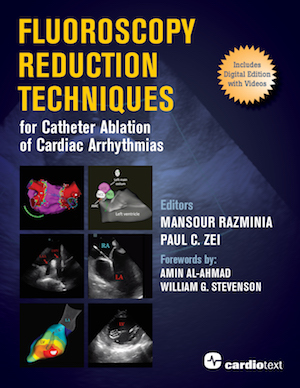Anatomy for Cardiac Electrophysiologists - Ho, Ernst
Anatomy for Cardiac Electrophysiologists - Ho, Ernst
Available at Amazon and Other Retailers
Anatomy for Cardiac Electrophysiologists: A Practical Handbook
By S. Yen Ho and Sabine Ernst
Foreword by: Melvin M. Scheinman
Publication Details:
Published August 2012
ISBN: 9780979016448
Paperback ISBN: 9781942909460
Trim Size: 11 x 8.25 inches, landscape
264 pages, full color interior
Format: Paperback
This highly visual handbook integrates cardiac anatomy and the state-of-the-art imaging techniques used in today's catheter or electrophysiology laboratory, guiding readers to a comprehensive understanding of both normal cardiac anatomy and the structures associated with complex heart disease.
Well organized, easily navigable, and superbly illustrated in a landscape format, this unique text invites the reader on a visual intracardiac journey via stunning images and schematic illustrations, including such imaging modalities as computed tomography, magnetic resonance imaging, ultrasound, radiography, and 3D mapping. Each chapter couples the electrophysiology perspective with detailed descriptions of the anatomic features relevant to a wide variety of arrhythmias, including:
Supraventricular tachycardias
Atrial fibrillation
Ventricular arrhythmias
With an overview of general cardiac anatomy, congenital malformations, standard catheter positioning, and potential pitfalls, Anatomy for Cardiac Electrophysiologists provides a solid foundation and quick reference for trainees as they prepare for the realities of the catheter laboratory as well as an excellent refresher for experienced operators.
“The anatomic figures that are provided are spectacular....This gem of a book stands alone as a brilliant starting point to meld interventional techniques such as ablation with the intricacies of cardiac anatomy….I highly recommend this eminently readable and superb contribution not only to the beginning trainee in cardiac electrophysiology but also to my more experienced colleagues.”
- From the Foreword by Melvin M. Scheinman, MD
Authors:
S. Yen Ho, PhD, FRCPath, FESC; Professor of Cardiac Morphology, Consultant, Royal Brompton Hospital, London, UK
Professor Ho is an expert in the postmortem examination of normally structured hearts, hearts with conduction disturbance, and hearts with congenital malformations. An internationally renowned speaker and lecturer, she has authored nearly 400 peer-reviewed articles, 100 textbook chapters, and eight books. She serves on the Editorial Boards of Asian Cardiovascular and Thoracic Surgery Annals and the Journal of Cardiovascular Electrophysiology, and is the current chairperson of the ESC Working Group on Development, Anatomy and Pathology.
Sabine Ernst, MD, PhD, FESC; Research Lead Electrophysiology, Consultant Cardiologist, Royal Brompton Hospital, London, UK
A pioneer in developing the technique of magnetic catheter ablation, Dr. Ernst's clinical expertise is focused largely on ablation of complex arrhythmias with a special emphasis on atrial fibrillation, ventricular tachycardia, and ablations in patients with complex congenital heart disease. She serves on the Editorial Boards of the Journal of Interventional Cardiovascular Electrophysiology and Europace, and has coauthored several chapters in cardiology and electrophysiology textbooks.
Table of Contents:
Part I: Overview of Anatomy and Imaging
Chapter 1: General Anatomy of the Heart
Chapter 2: The Neighborhood and Collateral Damage
Chapter 3: Overview of Imaging Modalities: Pros and Cons
Chapter 4: Positioning of Standard Catheters: Electrophysiology and Anatomy
Part II: Atria
Chapter 5: Electrical Anatomy and Accessory Pathways
Chapter 6: The Right Atrium Relevant to Supraventricular Tachycardia
Chapter 7: The Atrial Septum and Transseptal Access
Chapter 8: The Left Atrium and Pulmonary Veins Relevant to AF Ablation
Part III: Ventricles and Malformations
Chapter 9: The Right Ventricle
Chapter 10: The Left Ventricle
Chapter 11: Congenital Heart Malformations
Part IV: Pitfalls
Chapter 12: Pitfalls and Troubleshooting
Doody's Review Service:
Reviewer
Mario Pascual, MD(Ochsner Clinic Foundation)
Description
This is a handbook on cardiac anatomy and cardiac imaging techniques.
Purpose
It combines fluoroscopic techniques, 3D imaging modalities, and 3D mapping systems to facilitate the understanding of cardiac anatomy from an electrophysiologist's perspective.
Audience
It is intended for physicians in training and clinical electrophysiologists. The authors, both from Royal Brompton Hospital in London, include a professor of cardiac morphology and an electrophysiologist.
Features
This book details anatomical features relevant to arrhythmias and electrophysiological procedures. It starts off with a quick overview of normal anatomy, incorporating conventional fluoroscopic and advanced 3D imaging modalities. The electrical anatomy for supraventricular arrhythmias is explored and the manipulation of catheters to reach these targets is discussed. More advanced anatomy and catheter manipulation techniques then follow, and include detailed descriptions and illustrations of transseptal punctures and pulmonary vein isolation. The final section assesses more complex arrhythmias, including those involving both ventricular chambers and those found in congenital heart malformations.
Assessment
This is an excellent tutorial on cardiac anatomy as it pertains to electrophysiology.


